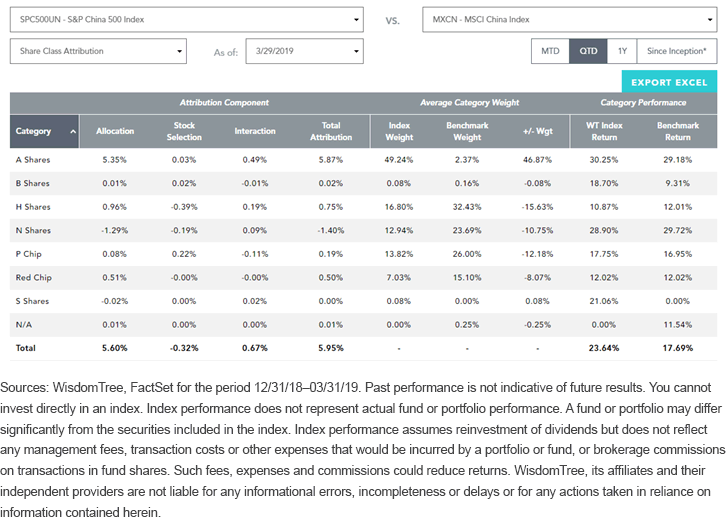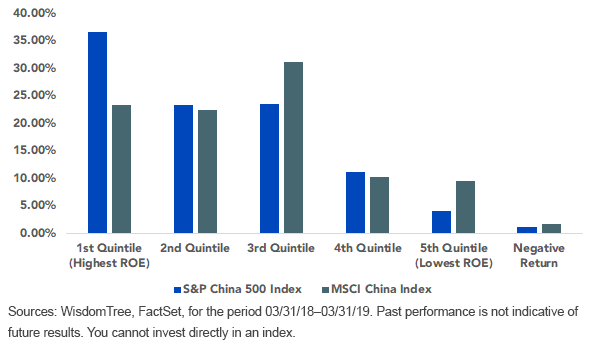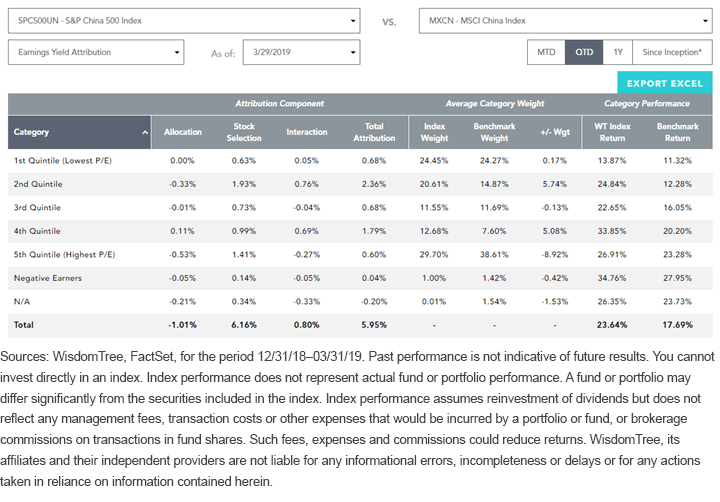What's Performing in China?


While we remain optimistic that a U.S.–China trade deal will ultimately be reached, investors need greater transparency into what’s performing (or not) in the Chinese equity market. To help, we’ve created tools that break down performance by a variety of factors including share class.
In December 2017, WisdomTree partnered with Standard & Poor’s (S&P) to launch the most inclusive Chinese beta product that tracks the S&P China 500 Index.
The WisdomTree ICBCCS S&P China 500 Fund (WCHN) gives investors seeking a beta exposure to Chinese equities access to the broadest diversity of opportunities in the market by investing in H-shares, B-shares, A-shares and P-chips: shares listed in Hong Kong, Shanghai, Shenzhen, Singapore and New York.
In addition to improving on Chinese beta exposure, we’ve also developed tools that can help investors stay up-to-date on what’s driving returns in Chinese equity markets.
Share Class Attribution
We recently discussed how the different approaches of various index providers to China’s financial market liberalization can severely affect an investor’s return and experience. There was a great deal of market interest when MSCI announced they would start to include A-shares in the summer of 2017. Since then, despite A-shares representing the largest segment of the Chinese equity market, current A-share exposure in the MSCI China Index is just over 2%. In our view, the S&P China 500 Index provides a more representative exposure by allocating close to 50% to mainland shares.
Breaking down exposures by share class, we are able to show the impact of gaining broad access to the Chinese equity market. In the performance attribution report below (available to financial professionals at www.wisdomtree.com), we can see how the S&P China 500 Index has a more balanced exposure across the different share classes than the MSCI China Index, which limits its exposure to class A-shares.
Since the beginning of 2019, the Chinese equity market has experienced strong growth and the S&P China 500 Index has been in its best position to take advantage of this rebound, having nearly 50% exposure to class A-shares versus the MSCI China Index’s 2.05%. This allocation was the primary driver for the almost 600 basis points (bps) of outperformance in the first quarter of the year.

Better Value and Higher Quality
Another consequence of having an increased exposure to class A-shares comes in the form of better valuations and increased quality as measured by price-to-earnings (P/E) and return on equity (ROE), respectively. Using our tools, we can see that over the last year, the S&P China 500 Index has had higher average exposure to the highest ROE quintile while also being underweight in the lowest ROE quintile and negative earners.
Average Portfolio Weight - ROE Quintlies

Next, we view attribution through the lens of earnings yields. To review, earnings yield is simply the reciprocal of the price-to-earnings ratio. In terms of P/E quintiles, we can see that having a better valuation and lower exposure to the most expensive (highest P/E) quintile has translated into outperformance since the beginning of the year.

In our view, there will continue to be increased convergence between the role that China plays in the global economy and the role it plays in global portfolios. Through our collaboration with S&P, we are able to provide exposure to the most inclusive Chinese beta product, WCHN, that tracks the S&P China 500 Index. Through our investment in technology, we continue to develop best of breed tools to help investors not only track returns, but also understand what factors and fundamentals are driving them.
Important Risks Related to this Article
There are risks associated with investing, including possible loss of principal. Foreign investing involves special risks, such as risk of loss from currency fluctuation or political or economic uncertainty. The Fund focuses its investments in China, including A-shares, which include risk of the RQFII regime and Stock Connect program, thereby increasing the impact of events and developments associated with the region which can adversely affect performance. Investments in emerging or offshore markets are generally less liquid and less efficient than investments in developed markets and are subject to additional risks, such as risks of adverse governmental regulation and intervention or political developments. The Fund’s exposure to certain sectors may increases its vulnerability to any single economic or regulatory development related to such sector. As this Fund can have a high concentration in some issuers, the Fund can be adversely impacted by changes affecting those issuers. The Fund will be required to include cash as part of its redemption proceeds which introduces additional risks, particularly due to the potential volatility in the Chinese market and market closures. The Fund invests in the securities included in, or representative of, its Index regardless of their investment merit and the Fund does not attempt to outperform its Index or take defensive positions in declining markets. Due to the investment strategy of this Fund it may make higher capital gain distributions than other ETFs. Please read the Fund’s prospectus for specific details regarding the Fund’s risk profile.

Alejandro Saltiel joined WisdomTree in May 2017 as part of the Quantitative Research team. Alejandro oversees the firm’s Equity indexes and actively managed ETFs. He is also involved in the design and analysis of new and existing strategies. Alejandro leads the quantitative analysis efforts across equities and alternatives and contributes to the firm’s website tools and model portfolio infrastructure. Prior to joining WisdomTree, Alejandro worked at HSBC Asset Management’s Mexico City office as Portfolio Manager for multi-asset mutual funds. Alejandro received his Master’s in Financial Engineering degree from Columbia University in 2017 and a Bachelor’s in Engineering degree from the Instituto Tecnológico Autónomo de México (ITAM) in 2010. He is a holder of the Chartered Financial Analyst designation.

